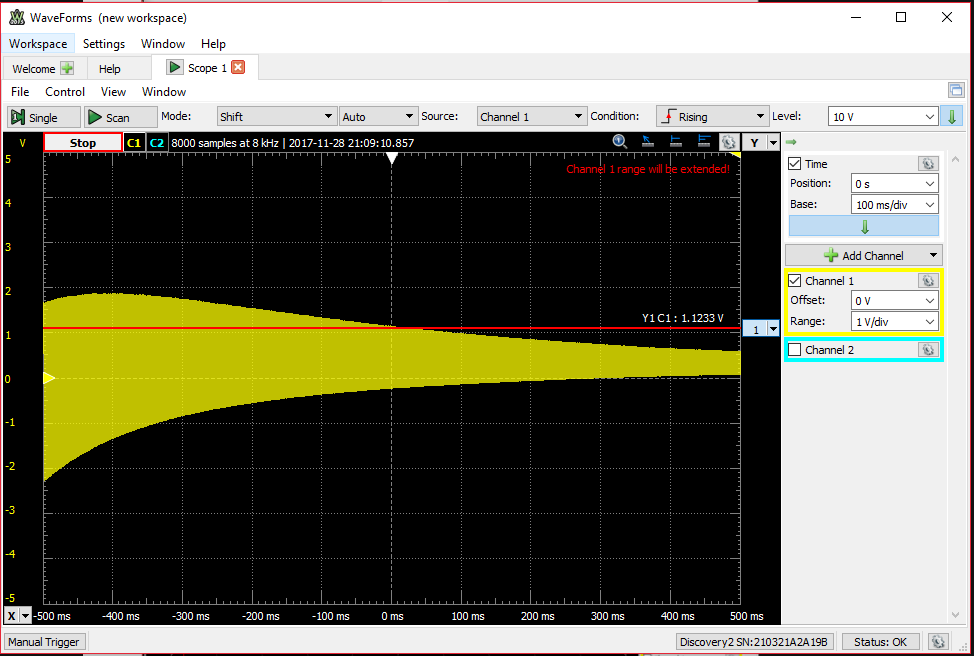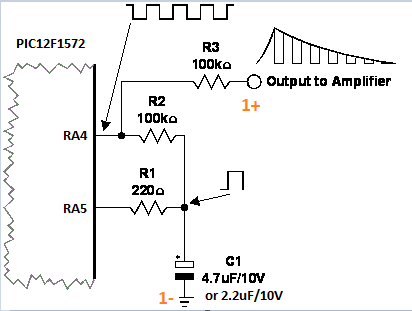After adding a 100nF capacitor in between the 100K resistor and the scope input, the DC is remove, left the square wave centered, peak to peak around +4 and -4V. Fair enough.
The reason of the previous log' incomplete decaying of the amplitude is due to the Analog Discovery 2's I/O tool which doesn't supply the full +5V on it. When I connect the +5V supply in their "Supplies" tool, the whole decay is complete!

There is a huge jolt when the note is struck. I'm also investigating that a bit. I have programmed a simple run where it keeps hitting and releasing the note at 500Hz. The code is as follows (use MikroC, within the Demo limit!) :
void timer1interrupt() iv 0x0004 ics ICS_AUTO {
TRISA.TRISA4 ^= 1;
//PORTA.RA4 ^= 1;
TMR1 = 64536;
PIR1.TMR1IF = 0;
}
void init() {
//OSCCON.SPLLEN = 1; // PLL turned off.
//OSCCON.IRCF = 0b1110; // 8mhz internal oscillator.
//OSCCON.SCS = 0b10;
OSCCON.SPLLEN = 0; // disable Software PLL.
OSCCON.IRCF3 = 1; // 8mhz -> 32mhz if PLLx4 set.
OSCCON.IRCF2 = 1;
OSCCON.IRCF1 = 1;
OSCCON.IRCF0 = 0;
OSCCON.SCS1 = 0; // system clock select: internal osc.
OSCCON.SCS0 = 0;
APFCON.P1SEL = 0;
APFCON.P2SEL = 1;
ANSELA = 0x00;
TRISA = 0x00;
LATA = 0b00010000;
INTCON = 0x00;
}
void init_intr() {
// Please look at the datasheet for the PIC12F1572 for more info!
PIR1 = 0x00;
PIE3 = 0x00;
PIE1.TMR1IE = 1;
INTCON.PEIE = 1;
INTCON.GIE = 1;
}
void init_timer1() {
// Timer1 clock source follows instruction clock!
T1CON = 0x00;
T1CON.T1CKPS0 = 1; // 1:8 prescale value.
T1CON.T1CKPS1 = 1;
TMR1 = 64536;
T1GCON = 0x00;
T1CON.TMR1ON = 1;
}
void main() {
init();
delay_ms(50);
init_intr();
PORTA.RA5 = 0;
init_timer1();
while(1) {
TRISA.TRISA5 = 1;
delay_ms(2500);
TRISA.TRISA5 = 0;
delay_ms(100);
}
}

And here it goes, it keeps hitting the note and decays for 2.5 seconds over and over again.
Now I'm gonna attach the thing to the cheap LM386 module I have here and hear it. Hopefully it'll be good this time! :)
Discussions
Become a Hackaday.io Member
Create an account to leave a comment. Already have an account? Log In.